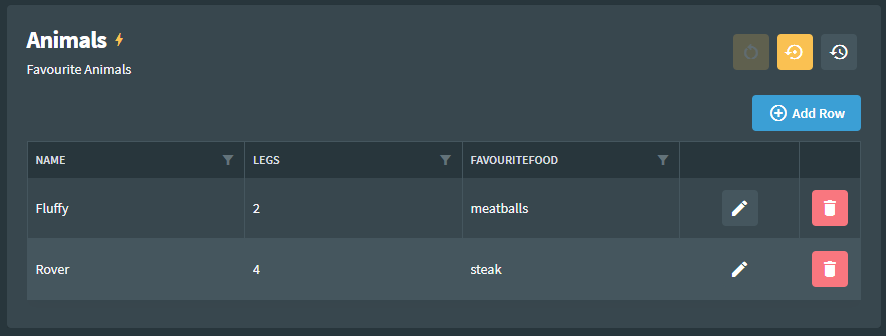Data Grids
Fig supports data grids for displaying complex settings.
Usage
The following setting will result in a data grid with 3 columns, one for each property within the class. Items can be added, removed or edited as required.
For properties to be added they must:
- Be public
- Have a setter and a getter
- Not be ignored
[Setting("Favorite Animals")]
public List<Animal> Animals { get; set; }
public class Animal
{
public string Name { get; set; }
public int Legs { get; set; }
public string FavoriteFood { get; set; }
}
You can also create a data grid from a list of base types, for example:
[Setting("Favorite Names")]
public List<string> Names { get; set; }
Locking Data Grids
Data grids can also be locked. This prevents rows being added or removed. Existing rows can still be edited. To lock a data grid, used the DataGridLocked attribute.
[Setting("Favorite Animals")]
[DataGridLocked]
public List<Animal> Animals { get; set; }
Internal Attributes
Some attributes can also be used on the internal class including MultiLine, ValidValues, Secret and Validation. These work in the same way that they do on regular properties. In addition, there is:
[ReadOnly]attribute which makes that column read only when editing the data grid.[FigIgnore]attribute which does not add that property into fig. It will not be shown in the UI or set by Fig in any way.
[Setting("Favorite Animals")]
public List<Animal> Animals { get; set; }
public class Animal
{
[ReadOnly]
public string Name { get; set; }
[ValidValues("1", "2", "3")]
public int Legs { get; set; }
[MultiLine(3)]
[Validation(ValidationType.NotEmpty)]
public string FavoriteFood { get; set; }
[Secret]
public string Password { get;set; }
[FigIgnore]
public string? MyOtherProperty { get; set; }
// Note valid values must be set for List<string> within a data grid.
// Only List<string> is supported, not other enumerable types.
[ValidValues("A", "B", "C")]
public List<string> Items { get; set; }
}
Default Values
Data grids support default values but as they are complex objects, they cannot be specified within the attribute. To specify a default value, create a static class and reference it within the setting attribute. For example:
[Setting("Favorite Animals", defaultValueMethodName: nameof(GetAnimals))]
public List<Animal> Animals { get; set; }
public static List<Animal> GetAnimals()
{
return new List<Animal>()
{
new Animal
{
Name = "Fluffy",
Legs = 2,
FavoriteFood = "carrots"
},
new Animal()
{
Name = "Rover",
Legs = 4,
FavoriteFood = "steak"
}
};
}
Appearance

CSV Import and Export
From Fig 2.0 it is possible to import and export data from Data Grids. Exported data is quoted to avoid problems with commas appearing in values.
Import supports quoted data or unquoted data. If the data is invalid, feedback is provided on the reason for the rejected import.
Imported settings need to be saved once the import is complete.

Import and export buttons sit above the data grid
The above table exports to:
"Name","Legs","FavouriteFood","Things"
"spider","8","Insects","one,two"
"horse","4","Hay","three"